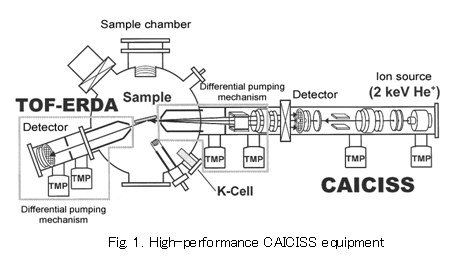The 1st (2001) Yamazaki-Teiichi Prize Winner Measurement Science and Technology
Development of Coaxial Impact-Collision Ion Scattering Spectroscopy and Its Application to In-situ Topmost Surface Analysis
| Winner | ||
|---|---|---|
| Mitsuhiro Katayama | ||
| Affiliation at the time of the award | ||
| Associate Professor, Department of Electronic Engineering, Graduate School of Engineering, Osaka University. |
Background of research and development
In connection with basic understanding of material surface properties and the development of semiconductor elements and the like, there is an increase in the necessity of in-situ analysis at the atomic level to determine composition and structure of the topmost atomic layer. In particular, in the field of actual development of semiconductor elements, for the purpose of detailed controlling of heteroepitaxy on semiconductor surfaces, necessity is increasing for real-time monitoring of semiconductor-surface composition and structure, which continue to change dynamically due to epixtaxial growth. Conventionally, reflection high-energy electron diffraction (RHEED) has often been applied for this purpose. However, since the information that can be obtained via a single method is obviously limited owing to such facts as surface elemental analysis not being possible, development of a new, supplementary method has been awaited. In response to this request, attention was focused on low-speed ion scattering spectroscopy (ISS), which is one method for analyzing material surface composition and structure. This method was advanced to develop a new method with low-speed ions used as probes.
Achievements
Low-speed ISS uses ions of low energy (measurable in keV). Therefore, not only is extremely sensitive measurement of the topmost surface layer possible, but so is simultaneous, real-time measurement of surface structure and composition, which continue to change dynamically. To sufficiently bring out the potential of this kind of ISS, the focus was placed on developing a specialized method of adopting the scattering angle, as was experimented with ISS, of a perfect 180°. In this case, the observed ions are those that collided directly (frontally) with the surface atoms. Thus, through ion scattering, the center of each surface atom is "seen," simplifying quantitative analysis of the atomic arrangement. The method developed features coaxial arrangement of the ion source, which is the probe, and the energy analyzer for particles scattered on the surface, realizing complete detection of backscattered particles. It was thus named coaxial impact collision ion scattering spectroscopy (CAICISS). The features of CAICISS equipment include (i) a 180° backscattered-particle detector, (ii) coaxial arrangement, and (iii) a time-of-flight energy analyzer. In this way, CAICISS itself possesses the following outstanding features that cannot be obtained with the conventional methods: (1) quantitative analysis of surface composition and structure can be conducted directly, (2) analysis of atomic layers from those under the surface to about several tens of atomic layers is possible, and (3) suitability for real-time measurement of dynamic processes on the surface.
In addition, to develop CAICISS as a method for in-situ measurement of surface processes, high-functionalization of CAICISS method was actualized (see Fig. 1) through such means as (1) the establishment of a method for in-situ measurement of the behavior of surface hydrogen and the surface processes through combination with time-of-flight elastic recoil detection analysis (TOF-ERDA) and (2) the development of an in-situ measurement device for gas phase atmospheres of up to 10-4 Torr through differential pumping of the detector part.
To verify the efficacy of in-situ analysis of the topmost surface of materials using the newly developed CAICISS method, this method was applied to the analysis of the atomic structure and thin film growth process of the topmost layer of semiconductors. As one example connected with analysis of the atomic structure of the topmost layer of semiconductors, the proposed model for the Ag monolayer thin film structure of an Si (111) substrate(Phys. Rev. Lett. 66, 2762 (1991) has been agreed as being a structural model that can explain nearly all of experiment results through other methods to analyze surface structure. Therefore, it is significant in terms of having elucidated one of the surface superstructures that had been a pending issue in surface science for many years. In addition, in in-situ analysis of the thin-film growth process, while monitoring composition and structure of growing surfaces via CAICISS, feedback was applied to the molecular beam epitaxy (MBE) equipment in real time, and the attempt to automatically control heteroepitaxial growth was conducted successfully (Phys. Rev. B54, 8600 (1996)). Recently, high-functionalized CAICISS method has been applied to in-situ measurement of the behavior of surface hydrogen and the accompanying surface processes, revealing interesting facts, including a spontaneous hydrogen terminated phenomenon on TiO2 (110) clean surfaces (Appl. Phys. Lett. 79, 2716 (2001)).
Research Prospects
The coaxial impact collision ion scattering spectroscopy (CAICISS) method proposed in 1986 was both adopted by numerous research groups and commercialized as a surface analyzer. At present, over 30 such devices are in operation around the world, and the method itself continues to spread as a standard surface analysis method. In addition, by highly functionalizing this method, it has become possible to conduct real-time measurement of surface hydrogen volume and in-situ measurement in gas phase atmosphere. Thus, wide-range application can be expected for in-situ analysis with processes where hydrogen mediates in the invention of materials, such as in chemical vapor deposition (CVD). In this way, we believe that this method will demonstrate influence as an in-situ measurement method for surface processes not only for the evaluation of surfaces and interfaces on the basic research level, but in the wide field of material development, as well.

